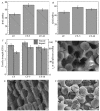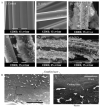Carbonaceous Materials Coated Carbon Fibre Reinforced Polymer Matrix Composites
- PMID: 34451310
- PMCID: PMC8399309
- DOI: 10.3390/polym13162771
Carbonaceous Materials Coated Carbon Fibre Reinforced Polymer Matrix Composites
Abstract
Carbon fibre reinforced polymer composites have high mechanical properties that make them exemplary engineered materials to carry loads and stresses. Coupling fibre and matrix together require good understanding of not only fibre morphology but also matrix rheology. One way of having a strongly coupled fibre and matrix interface is to size the reinforcing fibres by means of micro- or nanocarbon materials coating on the fibre surface. Common coating materials used are carbon nanotubes and nanofibres and graphene, and more recently carbon black (colloidal particles of virtually pure elemental carbon) and graphite. There are several chemical, thermal, and electrochemical processes that are used for coating the carbonous materials onto a carbon fibre surface. Sizing of fibres provides higher interfacial adhesion between fibre and matrix and allows better fibre wetting by the surrounded matrix material. This review paper goes over numerous techniques that are used for engineering the interface between both fibre and matrix systems, which is eventually the key to better mechanical properties of the composite systems.
Keywords: carbon fibre; carbon nanotube coating; chemical vapor deposition; fibre/matrix interface; graphene coating; mechanical properties; polymer composites.
Conflict of interest statement
The authors declare no conflict of interest.
Figures








References
-
- Njuguna J. Structural Nanocomposites: Perspectives for Future Applications. Springer Science and Business Media; New York, NY, USA: 2013.
-
- Soutis C. Carbon fiber reinforced plastics in aircraft construction. Mater. Sci. Eng. A. 2005;412:171–176. doi: 10.1016/j.msea.2005.08.064. - DOI
-
- Lewis S. The use of carbon fibre composites on military aircraft. Compos. Manuf. 1994;5:95–103. doi: 10.1016/0956-7143(94)90060-4. - DOI
Publication types
LinkOut - more resources
Full Text Sources

